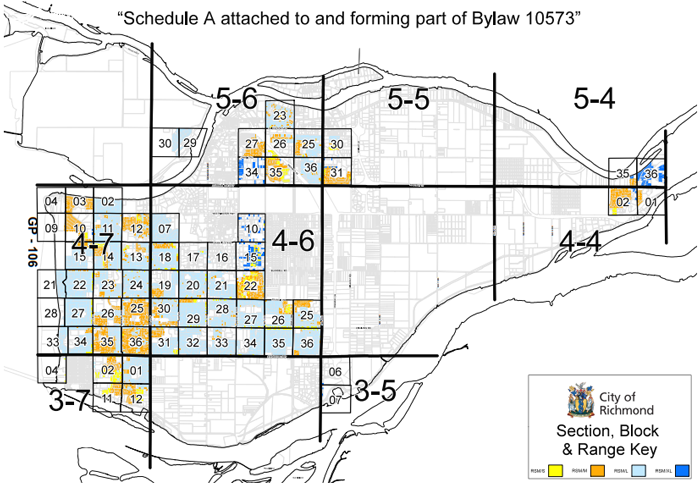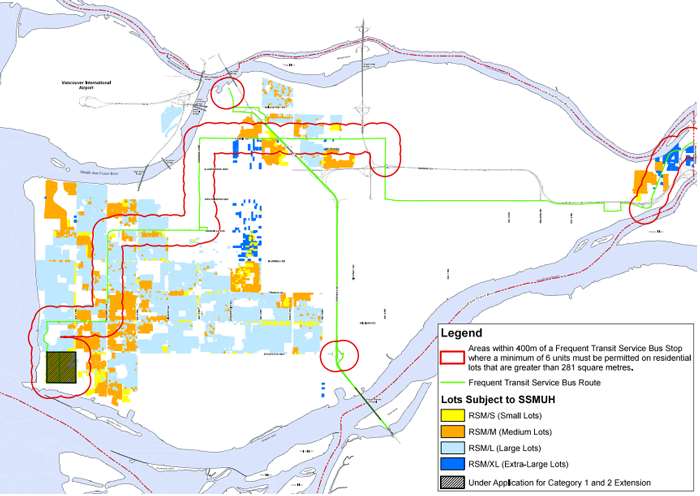Provincial Housing Legislation Changes

Impact of Bill 44 & Bill 47 on Richmond Residents
In November 2023, the Provincial Government imposed Legislation (Bill 44 & Bill 47) that will significantly change housing throughout British Columbia, including Richmond.
These changes affect the approval process for residential projects, and allow density increases beyond those traditionally permitted in most Richmond neighbourhoods. The Province has mandated these changes with the aim of addressing housing affordability by creating increased supply.
On June 24, 2024, Richmond Council:- amended the zoning of almost 27,000 single-family and duplex lots throughout the City to permit small-scale multi-unit housing (SSMUH) under Bill 44
- adopted a Transit-Oriented Areas (TOA) Bylaw to identify TOAs in the City and amended residential parking requirements within TOAs as required by Bill 47
It is important for residents to be aware of Bill 44 and Bill 47 and their impacts on the growth and character of Richmond and historic neighbourhoods such as Steveston. We hope the following information will answer some key questions.
Bill 44 - Small-scale Multi-unit Housing
How will Bill 44 affect Richmond?
The Province has imposed changes through Bill 44 (small-scale multi-unit housing) that require local government to prezone properties that were previously zoned for single-family or duplex use to allow multiplex buildings (three to six units). Because this is Provincial Legislation, the City must abide by these rules mandating the minimum number of units on residential properties.
Does the City of Richmond have to implement Bill 44?
Yes. These changes are now law and must be implemented with a bylaw no later than June 30, 2024.
How will Bill 44 change single-family neighbourhoods?
Bill 44 allows “Small-Scale Multi-Unit Housing” on almost 27,000 lots currently zoned for single-family and duplex uses. In Richmond, we allow at least one secondary suite and/or accessory dwelling unit such as a coach house or granny flat per lot. The Province now also requires the City to allow:
- a minimum of three units on residential lots with an area of 280m2 (3,014 ft2) or less
- a minimum of four units on residential lots with an area greater than 280m2 (3,014 ft2)
- a minimum of six units on residential lots with an area greater than 281m2 (3,014 ft2) located within 400m of bus stops with “frequent service” (15 minutes or less)
Note: the Bill 44 changes are not applicable to areas within a Transit-Oriented Area (see Bill 47 below).
Will the added density in neighbourhoods traditionally zoned for single-family homes and duplexes come with requirements for additional parking?
The Province suggests that minimum parking requirements should be reduced for areas that allow three to four units per lot. For areas that are allowed to have six units per lot (e.g., within 400m of a frequent service bus stop), the Provincial Legislation states that the minimum amount of off-street parking spaces can no longer be required. In those cases, the developer will now determine what parking, if any, is in place based on the perceived need. As a result, the City can no longer require parking in those areas.
Which properties will be affected?
The following maps show the location of 25,803 properties identified to be pre-zoned to a new zoning district to permit small-scale multi-unit housing and 277 duplex-zoned properties with zoning that will be amended to comply with new Provincial legislation that prescribes a minimum number of permitted units on an affected property. The documents below each map list associated property addresses.
Lots to be pre-zoned to a new zoning district to comply with Provincial Legislation

Block Range 3-5, 3-7, and 4-4
Block Range 4-6, Sections 07,10,15,16,17,18,19,20,21,22
Block Range 4-6, Sections 25,26,27,28,29,30
Block Range 4-6, Sections 31,32,33,34,35,36
Block Range 4-7, Sections 02,03,04,09,10,11,12
Block Range 4-7, Sections 13,14,15,21,22,23,24
Block Range 4-7, Sections 25,26,27,28,33,34,35,36
Block Range 5-4, 5-5, and 5-6
Lots with duplex zoning to be amended to comply with Provincial Legislation
How do “prescribed bus stops” affect small-scale multi-unit housing development?
Richmond is required to permit up to 6 dwelling units per lot within 400 m of a prescribed bus stop. A prescribed bus stop is a planned or existing bus stop served by at least one bus route with an average frequency of 15 minutes or less on weekdays (between 7:00am and 7:00pm) and weekends (between 10:00am and 6:00pm). Prescribed bus stop locations are not static and may change if TransLink relocates a bus stop or increases/decreases service levels. For this reason, the following map shows Richmond’s current prescribed bus stops, but the zoning bylaw does not specify prescribed bus stop locations.
Lots affected by current prescribed bus stops

Will the City be applying for any extensions from Bill 44?
Yes. The City applied for an extension from Bill 44 for the Steveston neighbourhood. The extension is required due to the ongoing Steveston sanitary sewer replacement program and the need to ensure this infrastructure work is completed prior to allowing small-scale multi-unit housing in the area.
On September 16, 2024, the Province granted the City of Richmond an extension to comply with Bill 44 rezoning to December 30, 2030, for the area bound by Steveston Highway to the north, No. 1 Road to the east, Chatham Street to the south, and 7th Avenue to the west.
More information can be found in the following news release: City Requests Bill 44 Deadline Extension.
Bill 47 - Transit Oriented Areas
What is a Transit-Oriented Area (TOA)?
The new Provincial legislation (Bill 47) defines a TOA as areas within 800 metres of a rapid transit station such as the Canada Line, and/or within 400 metres of a bus exchange.
What kind of development does Bill 47 allow in a TOA?
Bill 47 imposes the following densities and heights for residential buildings and mixed-used residential buildings in a TOA in Richmond and across Metro Vancouver:
| Transit hub type | Distance | Minimum height (storeys) | Minimum density (FAR) | Type of Building |
|---|---|---|---|---|
| Rapid transit station | <200m | 20 | 5.0 | Tower |
| 201-400m | 12 | 4.0 | Mid-high rise | |
| 401-800m | 8 | 3.0 | Mid-rise | |
| Bus exchange | <200m | 12 | 4.0 | Mid-high rise |
| 201-400m | 8 | 3.0 | Low-rise/townhouse |
In Richmond, five Canada Line Stations have been identified as a TOA (Bridgeport, Capstan, Aberdeen, Lansdowne, and Brighouse). No bus exchanges have been identified. The height and density requirements only apply to lands designated for residential uses, including mixed-use land designations that include residential. Also, Federal Airport Zoning Regulations and associated maximum building heights supersede the TOA building heights.
What changes to parking requirements will occur for developments in a TOA (i.e. around Canada Line stations)?
Bill 47 removes the City’s ability to require minimum residential off-street parking spaces for buildings within TOAs, except for accessible parking spaces. The Province has stated it wants parking volumes determined by market need and demand, regardless of the impact on neighbourhood access and character. The restriction does not apply to non-residential (i.e. commercial) off-street parking requirements.
Developing Financing
What impact will the increased density have on City infrastructure?
Both Bill 44 and Bill 47 will add additional density to many parts of Richmond. The increased density in traditional single-family neighbourhoods will place a strain on existing infrastructure such as drainage and sewer systems, as well as electrical and other services. The increased density will create a need for additional amenities beyond those already planned such as community centres, parks and libraries. The City will consider these potential impacts as we update our Official Community Plan (OCP).
How will the City fund the additional infrastructure and amenities needed to support the additional density/population Bill 44 and Bill 47 will bring?
Two other Provincial bills, Bill 16 and Bill 46, outline new tools including additional Development Cost Charges (DCCs) and a new Amenity Cost Charge (ACC) to help fund infrastructure needs as density grows. Through ongoing investment, the City continues to upgrade infrastructure, services and amenities in as many neighborhoods as it can. The challenge will be keeping pace with the level of density imposed under Bill 44 and Bill 47. The City is investigating how best to utilize these financial tools to support infrastructure and amenities.
Public Input
Will there still be Public Hearings?
Under Bill 44, the Province no longer allows Public Hearings for housing projects that are consistent with the Official Community Plan. As residential projects make up approximately 90 per cent of the Public Hearing agenda, there will be few – if any – Public Hearings outside those mandated in Legislation. The City is looking at other means of obtaining community input on developments, as it is important for residents to be aware of changes in their neighbourhood.
Will residents have input into projects in their neighbourhoods?
Signage will still be in place to identify a property subject to a rezoning application, and residents and businesses within 100m of the property will receive notification by mail. Information on each application will be posted on the City’s website, and City staff will continue to answer questions by mail, email, telephone and via in-person meetings.
Will the City be hosting any open houses on the impacts from Bill 44?
A series of in-person open houses at Community Centres in Steveston, Hamilton, South Arm and Thompson took place from July 9 to 17, 2024 and were attended by approximately 1,800 people.
Additional Resources
- City of Richmond Council Meeting Agenda - Jun 24, 2024
Refer to:- CNCL - 688 (page 688) for Richmond Zoning Bylaw 8500 Amendment Bylaw 10561 (Transit-Oriented Areas)
- CNCL - 691 (page 691) for Response to Motion from General Purposes Committee to Provide Supplementary Analysis of Stratification and Rental Tenure Options for Small-Scale Multi-Unit Housing Development
- Bylaw 10573 - Small-Scale Multi-Unit Housing (RSM/S, RSM/M, RSM/L, RSM/XL)
- Bylaw 10560 - Transit-Oriented Areas (TOA) Designation
- Bulletin Planning-08 - Response to New Provincial Housing Legislation Bill 47: Transit-Oriented Areas (TOA)
- Bulletin Planning-09 - Small-Scale Multi-Unit Housing
- Visit the Province’s website for more information on the Provincial housing bills.


